Event Photography- Photographing a Restaurant Opening
By Ashwin Rao – Ashwin’s blog can be seen HERE
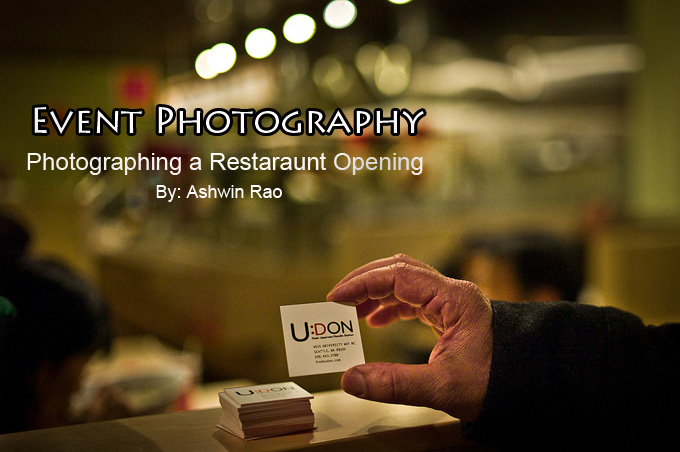
Hi everyone, it’s Ashwin, back with a short and sweet post (hopefully) as the New Year fast approaches. As many of us have gotten increasing experience with our cameras, we have received opportunities to port our cameras to events, such as weddings, sporting events, and gallery openings. Recently, I had the pleasure to be invited to the grand opening of the Seattle Restaurant U:Don, a Japanese noodle station in which the udon noodles are manufactured in house and served in a variety of delicious preparations.
I am acquainted with the Station’s owner and family members, and so I had early access to the big opening. Of course, along with me came the trusty Leica M9 and my fast-developing favorite lens, the 35 mm f/1.4 Summilux Asph FLE lens, as well as the nice 21 mm f/3.4 Super-Elmar and 75 mm f/2 APO-Summicron Asph.
A busy opening night….21 Super Elmar
I had a blast photographing the event, after polishing off a delicious bowl of wonderful noodles, with beef brisket, and all of the fixings. A happy belly makes a happy photographer, or so they say (wait, I think I just made that up). Regardless, I had the opportunity to take a nix mix of photos of the grand opening of U:Don, and present them here.
The Line Chefs in Action: 35 FLE
I primarily shot the lenses wide open, hand-held, at ISO 50, using Auto-WB (though fluorescent settings would have worked fine as well. I kept shutter speeds about 1/45 s, in general, though I took some liberties to shoot as slow as 1/24 sec with the 21 mm Super-Elmar. I only mention this, as a good rule of thumb for shooting hand-held is to shoot no slower than 1/focal length. That is, for a 35 mm lens, shoot at 1/35 s or faster shutter speed, and so on.
Head chef Tak Kurachi: 35 FLE
Line Chef/Noodle Master: 35 FLE
[ad#Adsense Blog Sq Embed Image]
Event photography poses many challenges, and variable lighting is in fact a big one. As you can see from the pictures, U:Don’s décor incorporates a variety of palettes, including warm neutral wood stock, red and brown accents, and sheet metal, along with reflective surfaces. I used a variety of perspectives, focal lengths, color/b&w profiles, and angles to capture the opening event in a way that I thought was representative of a typically busy night at this restaurant, which I hope will be a great success, not only as I know the head chef, but also because the food is fantastic, and good food should never go unrewarded.
Chef and Sous-Chef: 75 APO-Cron
Patrons Lining up for the Goods: 35 FLE
Sure, it would have been nice to have a camera with ridiculous high ISO performance, Vibration control/image stabilization, and crazy zooms, but me, M9, and 3 lenses seemed to do the trick just fine. In fact, keeping a simple kit of 1-3 lenses and 1-2 bodies is suffient for nearly all perspectives for your photography. You may find that the simplicity of shooting in this manner stimulates and challenges your creativity in ways that are both refreshing and rewarding. I certainly have….
U:Don Sign: 35 FLE
Chowin’ down: 35 FLE
Servin’ Up the Tempura Fixin’s
If you are ever in Seattle and are craving a soup/noodle/Japanese cuisine fix, you can find U:Don in Seattle’s University District, at 4515 University Way NE, Seattle, WA 98105….U(just ful disclosure, that I have no stake in U:Don, other than a satisfied customer with a happy belly and some fun photos to share).:
Happy holidays to everyone!
Ashwin

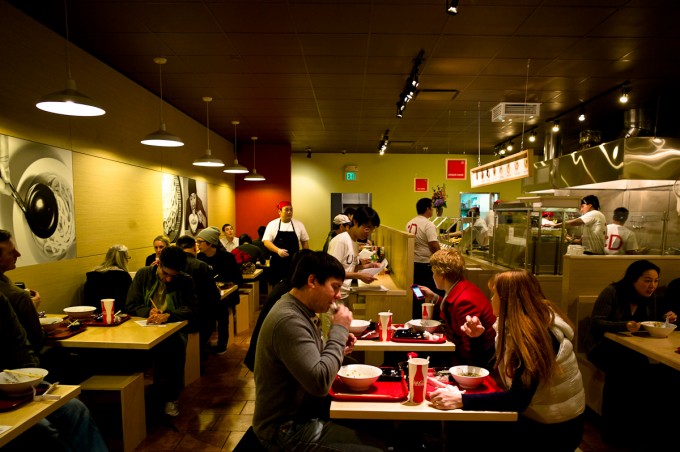
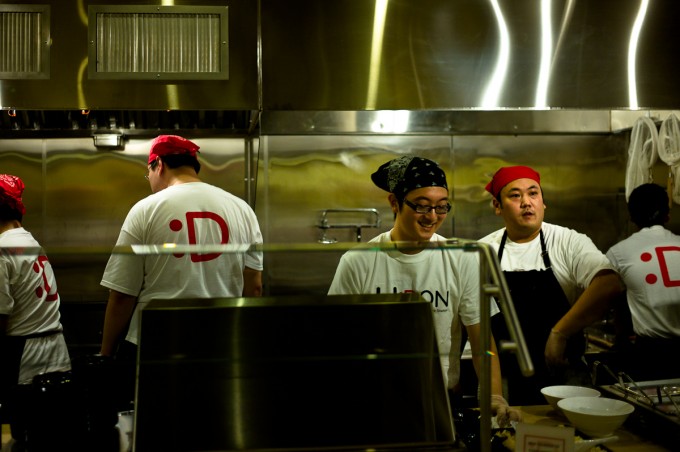
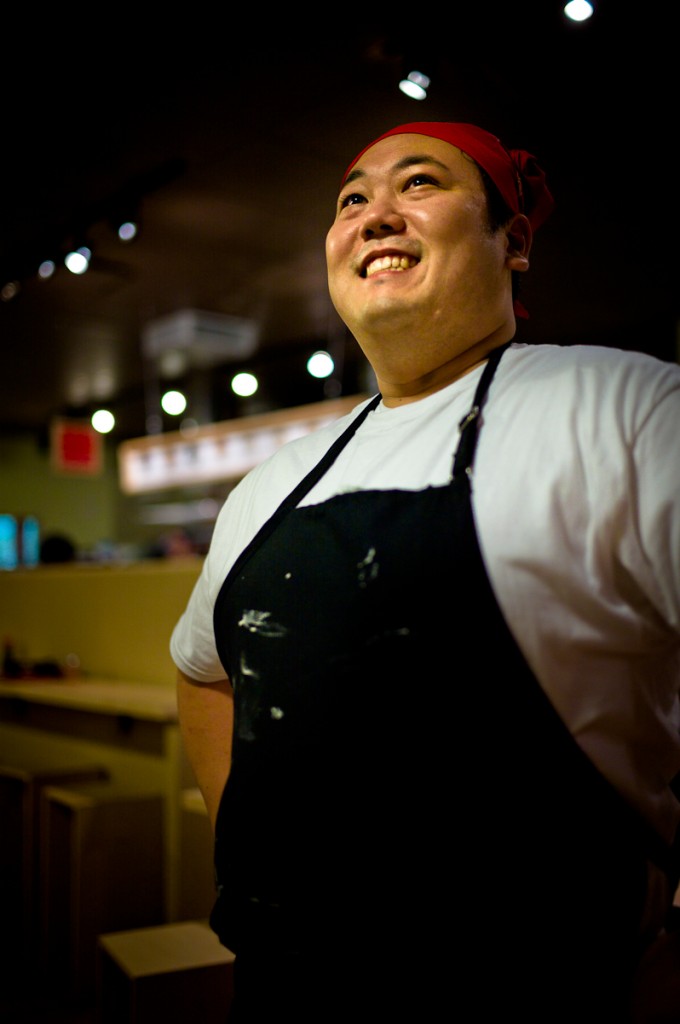
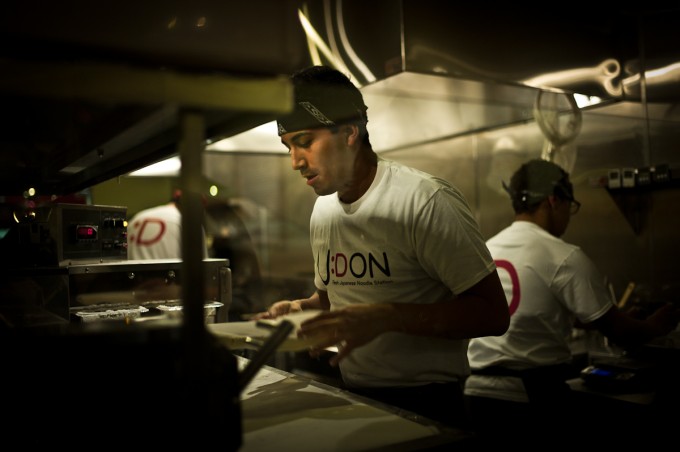
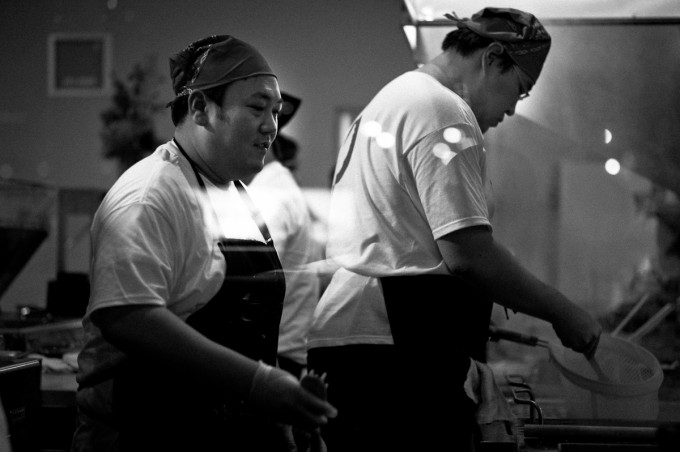
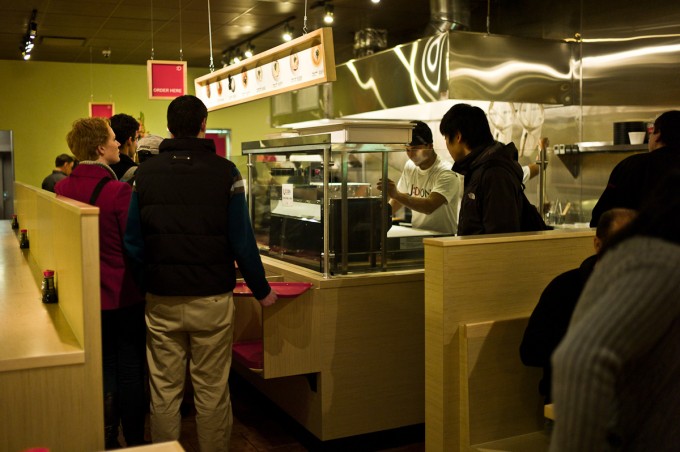
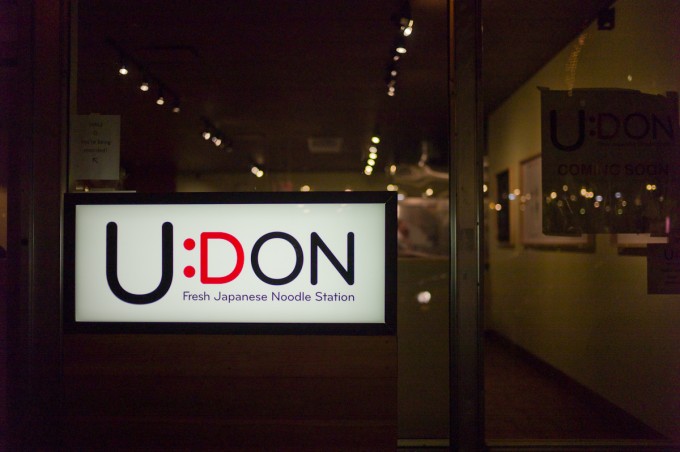
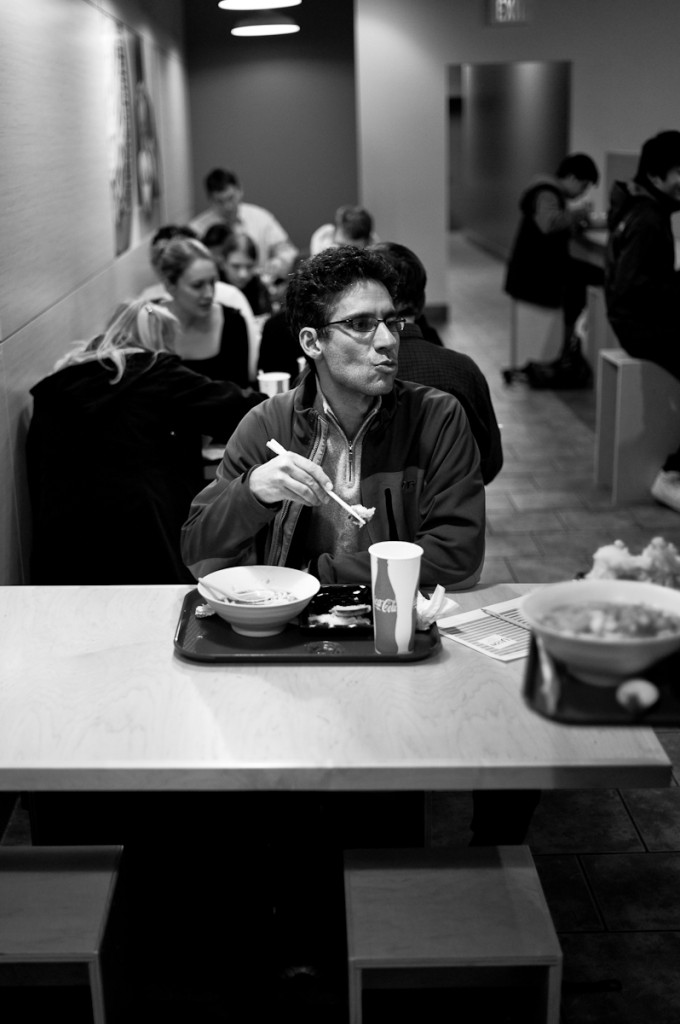
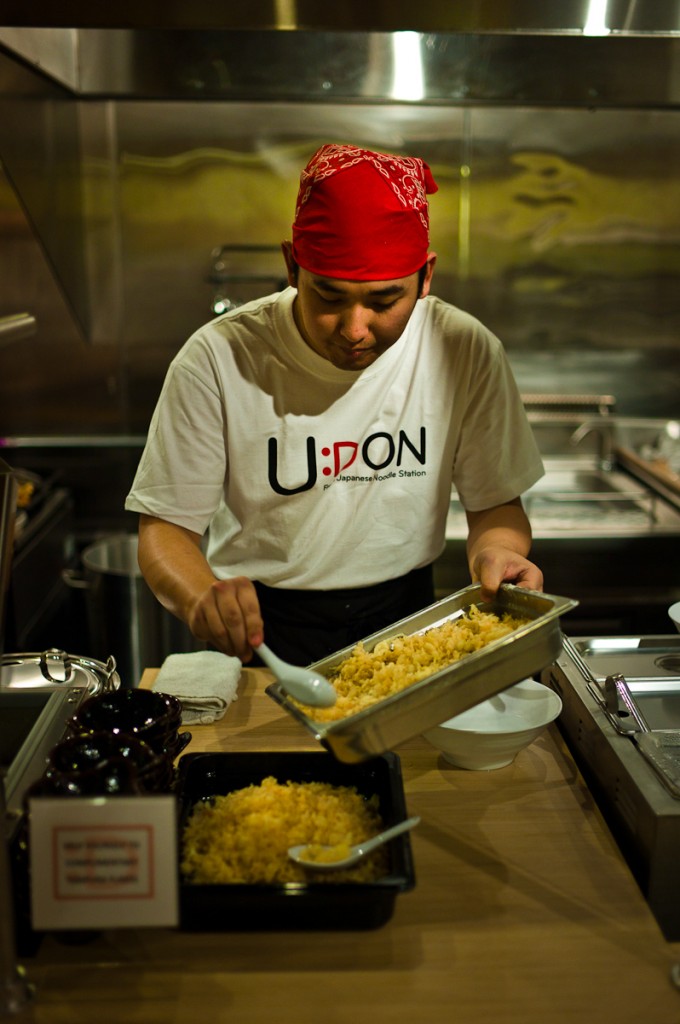

Lovely images. I’m eager to use my m9 more for event photography which is my main genre of work. I am still nervous and end up relying on my canons for the work.
Well done on a nice set of images. Id like to see more faces etc. I think that people standing around in low light environments is the biggest challenge to event work with the m9.
Nice works!Thanks! Is the 35 lens you use as a one lens kit all around ? Or, which lens you prefer on your RF(I mean focal length)?
Hi Carsia, I enjoy 35/50/90 as a 3 lens kit. If had to choose 1 lens only, it’d be a 50 mm lens, though the 35 mm lens is quite versatile as well.
Hi Ashwin!
Thx for your replies – and yes – it never should have been/has been a critic by myself on your photographic skills, as I wrote already – I really respect your high level of photography especially with the M9, here and over at dpreview.com.
And not to forget to mention – YES I do “love” my M9/noctilux too, really do care about the equipment but for sports/theater/opera shooting of course I am using my D3s,
😉
Hi Michael, No offense taken. I appreciate all of the constructive criticism and critique, as it helps me grow as a photographer. Thanks for keeping track of my photos. The M9/Noctliux combo is fantastic, but yes, not a champion for sports or opera work….the D3S is quite nice for those tasks 😉
Glad to read – and that you as myself are using the 35/50/90 lens combo with the M9 shows at least one thing we do have in common!
😉
And yes, D3s is another great piece of technology too…(besides the beloved M9 of course).
Surely, ISO 50 must be a typo ?? From my experience, I wouldn’t expect exposures of 1/45, F/1.4 in this kind of environment…
Whoops….ISO 640…..somehow, that got mistyped. Thanks for catching that ;)…
I see lots of people with not so nice shadows cross their faces, people standing in line photographed from back, signs, people while chewing with food in their mouth, lots of blacked shadows, few details. I for myself dont feel invited by those pictures and ive got no clue about what kind of restaurant this is. I see no decisive moments either and no thoroughful compositions. It more like shooting from the hip or spray and pray with some point and shoot. Imfor myself dont like it.
me neither. no shots really show off the perspective. or high details. or angles for smooth transitioning bokeh. a couple off camera flashes would have been nicer. this is almost like street shooting except in low light. it doesn’t make the restaurant have the glamorous appeal.
agreed with both of you. Although i’ve seen some really nice shots from Ashwin before, these make the restaurant seem very cold and clinical. I don’t know if the answer is a different take in processing, or if it’s simply the limitation of the equipment in that sort of environment….
Entirely my limitation and interpretation. I wouldn’t blame the gear, but rather the subjective interpretation of both myself and the viewer’s response. It’s okay not to like the images…I have been using Kodachrome LR3 presets, and this may contribute a bit….
I continue to enjoy the images, but understand where you and those above are coming from. The 35 FLE is a contrasty lens, and the overhead lighting adds to the contrast….
That being said, one could save a lot of money and get a less contrasty 35 and get a different effect, or in my case, process the images differently. Thanks for the input to you, Lynn, and Deff.
Hi Ashwin,
great pictures! I completely disagree with most of the criticism posted here. For me the M9 is a great camera for this kind of events as your pictures show. The saturated and contrasty look comes partly from the sensor but mostly I think from the great Leica lenses. I noticed similar deep colors in full sunshine – so it has not much to do with the light levels. Thank you also for leaving the exif information in place so one can check the shooting information. Thanks to the 35 ‘lux you still had plenty short exposure times, there was certainly enough light for the M9. The only thing I might suggest would be to try a custom white balance with a grey card next time.
Peter
Thanks, Peter…yeah, I think that’s a good idea, but I tend to minimize my kit, but a grey card could certainly be handy 😉
They are a little green but I did not notice it until someone mentioned it.
I think they are great photos as usual from you Ashwin.
Anytime a camera is at the top of the camera pricing scheme it is going to be critiqued to death. And rightfully so I suppose.
Thanks, Brian!
Can you please explain the reasoning behind the “rule of thumb for shooting hand-held is to shoot no slower than 1/focal length. That is, for a 35 mm lens, shoot at 1/35 s or faster shutter speed, and so on.” Is that mirror less specific or same rule applies to SLR? I also assume that it applies to both film and digital? Thanks for the lesson!
Generally, in order to have a in-focus image, without motion artifacts related to hand shake, shooting at 1/focal length is appropriate. With wider lenses (say the 21 SE), motion artifact is less pronounced, as the effect is sort of spread across the whole field of view. SImilarly, for long lenses, the effect is more pronounced with the same amount of hand shake/tremor/etc…
This particularly pertains to non-image stabilized solutions, such as the M9 and many smaller system set ups. Most SLR’s have some form of lens-based (Canon, Nikon) or body based (Pentax) image stabilization feature that allows one to stop down a bit further with seeing motion artifacts from hand holding. That being said, in my experience, holding larger cameras imparts a bit more shake, and I find a more comfortable and firm grip on a smaller camera such as the M9…so that there are some situations where I’ll photograph handheld at “less than” 1/focal length (i.e. shooting a 35 mm lens at 1/15 sec) and get away with it….
For a little historical background, the “rule” of using a shutter speed of 1/focal length was most likely developed by press photographers. This rule works well with the cameras used up thru the 1950’s (Speed Graphic, TLR’s, range finder 35mm, etc.). It also worked fairly well with the first generations of SLR camera. Though, as technology progressed and features like auto exposure and auto focus were added the rule became less effective, since with each new feature the time lag between pressing the shutter button and the shutter actually opening has increased giving more opportunity for human jitter to affect the image. From my experience, I now try to use 1/(2x focal length) when using an SLR. I have not considered the effect a crop sensor would have, so the previous comments do make sense.
Unfortunately, it appears the photo education world has not noticed the the “rule” is not that effective, as the original rule is still being taught.
PaulB
The rule of thumb is 1/focal length on a full frame camera. So on a M9 or 5D2, if you have a 50mm lens, you want a shutter speed of 1/50 to minimize hand motion blur. On a cropped sensor lens like a micro 4/3 camera, the crop factor is 2X. So for a 25mm lens in a Panasonic GH2, it would be 1/50 (25mm x 2). A Canon T3i has a crop factor of 1.6X and most other APS-C cameras have crop factors of 1.5X. The rule of thumb also differs from user to user as some people have steady hands, while others don’t.
For 35mm film cameras, it would be the same as a full frame.
I thought one of the advantages of a mirror less camera such as a rangefinder is the lack of mirror slap therefore allowing you to hand hold it one or two stops slower than a SLR?
Rob, you are right in that certain cameras do offer advantages over others in terms of reduced vibration caused by the shutter actuation. Although which camera provides the least “vibration” is also subject to debate. Nevertheless, the “rule of thumb” is a safe rule to follow regardless of the strengths and limitations of any given camera.
It’s also worth noting that this rule of thumb only applies to prominent major subjects, and the degree of acceptable unsharpness varies from photographer to photographer. Ansel Adams, as an extreme example, found 1/250 with a 50mm lens to be the slowest speed without degradation in sharpness. This was with a hand-held rangefinder. Even with a firm body support, he found blur in the background at 1/125.
So, my rule of thumb is: for the foreground, one over 2 * the focal length or faster, one over the focal length gives you just a little bit of foreground blur, and any slower gets progressively blurrier.
For the background: one over 4-5 * the focal length. One over 2 * the focal length is the limit, giving you just a little blur.
So, if I’m using a 50 mm lens, and am interested in the foreground, I’ll go down to 1/125 or even 1/50 sec before I start to worry. If I want the winter trees in the background to be sharp, I try not to go below 1/250, or at worst 1/125.
Great write up and photos Ashwin! I’m perplexed and amused by the criticisms regarding WB, using B&W to hide shortcomings, and posting things to prove versatility just to prove limitations. I’m just an amateur, so what do I really know. But out of all my likes and dislikes regarding my M9, WB is the least of my concerns. That’s easily adjusted when I’m processing the RAW files in Lightroom. Moreover, I have yet to encounter a camera that renders a perfect WB in mixed indoor lighting conditions. I’ve used the 5D2, XTi, K5, X100, NEX3/5N, EP2/3, GH2, V1, and a few others. As for picking a X100 over the M9 in such an indoor event, I totally agree that my X100 beats the pants off the M9 when it comes to high ISO stuff. But given that Ashwin was keeping the ISO low while still achieving fast enough shutter speeds, high ISO was not an issue. What is sometimes an issue with a X100 though, is the quirky AF. It can be hit or miss, under artificial lighting (same thing with the K5). No such issue with the M9’s simple and highly effective MF. At the end of the day, cameras are tools for the user to express themselves and document events. We all have different wants, needs and priorities. I don’t see the facination with labeling a great write up with great photos with negativity simply because one may find a Leica M9 to be not as suitable for certain shoots to him/her than another camera. Merry Christmas and happy new year to all!
Very well stated, Armando, and thanks! Yes, there are not many cameras that are good with color handling and AF handling in low light. The best I have seen for color, to date, is the GXR’s sensor, particularly at low and mid ISO’s (upto ISO 800). I love and own the K5, as well, but find the AF in indoor/low light to be marginal at best, leaving me frustrated at times with this otherwise wonderful camera. The M9 offers the “customizability of simplicty”, setting the focus, WB (if one desires), shutter speed and aperture to one’s desires and going from there….still, challenges remain, but Armando has said this better than I could….though, I keep thinking that an X100, which I gave up on early, may be in my future (though I’ll probably wait for its successor to correct Manual focus capacity, introduce focus peaking (hopefully), and improve AF speed accross the board….
Okay, I am gear-heading it up…gotta stop….
Alas, the coloring may have been my own approach to image processing, and that I have a touch of red-green color blindness …. Appreciate the feedback. Regardless of my own limitations, I think that they are more mine than the camera’s limitation, the the FLE is quite a contrasts lens ;). The soda is actually Jones Soda, a rather tasty local brew, despite what the cups may say….yeah, as for the food, The M9’s lack of macro was a limit…
Thanks for the feedback to you all. Very helpful!
All that nice food… and they drink Coke with it?? Barbaric :/
Nice shots though.
As often mentioned by myself especially on dpreview.com – “there a camera that make more sin being used for special occasions”…saying that, for example I never would use my M9 not even with Noctilux for shooting indoors @night. I would have brought the X100 if should be a light package or if I don’t care and SLR with a fast zoom lens. Outcome would have better overall IQ – the Kodak sensor is not made for high-iso nor for indoor shooting under artifical light – too much contrast, too much noise.
So IF I do have the choice – better, my personal opinion, not the M9 or the X1.
And yes – in black/white to can “hide” the shortcomings according color rendition and so on – as perfectly shown by Ashwin which I do respect for all his awesome work already shown here or on dpreview for a long time.
A little contrary post HERE but see it that way – nobody can accuse Steve that here is just a Leica praising forum.
😉
Wish you all a nice holiday season!
I can’t agree more. I really liked some of Ashwin’s earlier post here and he is definitelly highly skilled photographer it is definitelly a photographer issue or lack of postprocessing skills. It is a bit paradoxical that reallity distortion field of leica badge is so strong that people post things with the aim to prove versatility of the camera but just prove its limitations. It is definitelly very nice camera for landscape work and street photography but definitelly not for indoor events like the one above. Colours are off with the greenish hue, just have a look at the skin tones, I don’t like clinically correct white balance but greenish skin tones are not very appealing either. Black and white does cover up the flaws but flaws are there for anyone who wants to look impartialy at the photos. Also this is supposed to be about great food, but we don’t really see it (apart from big cans of coke, looks like any generic chain fast food restaraunt). Maybe because of rangefinders not being able to do macro or even close up shots.
just a correction-I meant to say-“it is deiniftelly NOT a photographer issue” 🙂
I’m not really sure I find much validity to what your’e saying. The M9 definitely isn’t the best at auto white balance, especially with mixed lighting, but all it takes it a manual white balance or a simple tweak to temperature in post to correct for this; the former being more ideal than the latter. I think Thorsten Overgaard has proved on many occasions how great the M9 can be for indoor event photography even in color.
With regards to close ups of food, sure, any other camera could get a much more intimate perspective than a rangefinder could, but with a .7 min close up you can still frame a plate nicely without having to stand far away. I simply think Ashwin was more concerned with representing “the big picture” and the mood/energy of the evening.
What is good about digital photography and modern cameras is that unless a person is absolutelly clueless about what she/he is doing almost anything can be saved with carefull postoprocessing but it is easeir if you can get it right in the first place, being able to not think of whether balance is going to be way off, not being forced to stick to base ISO and get much more blurry shots beacuse of that just enalbes a person to concentrate on comosition, dynamics of the scene etc and makes it easier not to end up with greenish snapshots.
The point is that M9 (and 8) do offer a few very unique advantages on the one side of the equation, as repeated here 10000000000 times they are much quiter and portable than any other full frame from canon, nikon and sony and therefore more suitable for certain types of photography. However, on the other hand there is also a longish list of limitations and subpar performance which does make them much less useful in other types of potography. The degree of importance or irrelevance of each side of the equation is, of course, to be determined by each photographer depending on his photographic background and priorities-you can for example use Nikon D3X with 70-200 2.8 lens for street photography, it can be done and you’ll get some great shots but you’ll look a bit ridicilous at best and not be able to capture intimate dynamics of the street life. Nikon will shine in other settings. Its the same with Leica and I just wanted to make a point that couple of posts here argued about use of M9 for the types of photography where it is just not suitable for, sure you can do it with M9 and even with camera phone as well but not going to get the best results. But I also understand that this is sort of Leica fan site where M9 has the status of a divine status and like divinity it can do anything, I just thing that sometimes it gets a bit too much
@ Mika, I do feel that the last statement below is a bit flawed. Yes, certain cameras are more adept for certain tasks. The extreme version is fast sporting action, such as soccer or US Football, where the M9’s lack of reach (nothing past 135 mm) and lack of fast tracking AF are limitations. Similarly, with macro photography, the M9 can’t really do that, so there’s another limitation.
To me, otherwise the M system offers a lot of flexibility:
1. Form factor that allows shooting hand held in a relatively steady manner
2. A focussing solution in low light that holds some advantages over inaccurate focus on some AF cameras (SLR’s, etc) which don’t do as well in low light
3. The implicty of setting up your shot (ISO, shutter speed, aperture, focal length) and taking photos simply…..
I am wuthpatrick on this one, and agree that Thorsten Overgaard shows the strengths of the M system over a wide range of indoor/event/and street photography situations….And Patrick’s right in that I was trying to capture a bigger picture view…once again a creative expression that I chose….
The idea that the camera offers more vs few advantages is one of subjective preference. I prefer the M9 for multiple reasons, over an SLR, but I have shot extensively with SLR’s as well….happens to be that I fall on the RF side of things for my enjoyment and style of photos, whereas for the majority of others, SLR’s or other large sensor compacts may be more appropriate….
Steve’s site does hold a special place for all things Leica, correct, but by no means are my comments blinded by my enjoyment of all things Leica…no divine status here….
Regardless, appreciate the civil debate and commentary here. Good way to hash it out 😉
I’m your side Patrick.
When they said it is not good or wrong it is because they don’t have the skills…
When they said your photo is not sharp it is because they don’t understand photography…
When they said if you have the “right hand” you can shoot great photo with an iPhone too but end up they using D3, 1D plus top quality lens to shoot their photo.
When they complain about white balance, noise and blah blah blah it is because they don’t know how and the important of post processing.
When they said post processing is wasting you time it is because they only know how to rely on a camera, when camera wrong, they wrong too.
When they said your photo is candid and no story or contents it is because they don’t have the imagination.
When they said how back is a Leica but actually they have plenty of Leica camera and lens in their dry box and praise deadly to own one if they don’t have one.
When they said how bad is this site but end up they came visit here daily and spend times to critic other people work.
When you are totally right and nothing to argue, they will complain your grammar suck! Your english bad! LOL LOL LOL LOL
Are they an award winner photographer? Nope, just they think they are so good.
Are they write up any articles or reviews to contributed before? Nope, they just complained, critic and judge in here only.
Are they own and maintaining a site like this? Nope, they only upload some photo via flicker and facebook or maybe a free blog to share with their small group of friends.
Are they a Leica fans too? 100% sure! If not, why the hell they own one and came here regularly? LOL LOL LOL
Hi. Great work, nice stuff. It’s amazing how the Leica M9 produces arty, very saturated images which technically have a very limited dynamic range, yet produce an intriguing look. I think it works especially well in black and white where the high contrast, hollowed out dynamic range produce dramatic images.